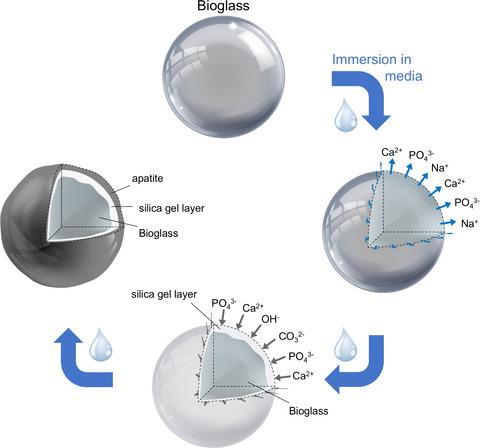当前位置:
X-MOL 学术
›
Int. J. Appl. Glass Sci.
›
论文详情
Our official English website, www.x-mol.net, welcomes your
feedback! (Note: you will need to create a separate account there.)
A review of acellular immersion tests on bioactive glasses––influence of medium on ion release and apatite formation
International Journal of Applied Glass Science ( IF 2.1 ) Pub Date : 2020-01-22 , DOI: 10.1111/ijag.15006 Amy Nommeots‐Nomm 1 , Leena Hupa 2 , Dana Rohanová 3 , Delia S. Brauer 4
International Journal of Applied Glass Science ( IF 2.1 ) Pub Date : 2020-01-22 , DOI: 10.1111/ijag.15006 Amy Nommeots‐Nomm 1 , Leena Hupa 2 , Dana Rohanová 3 , Delia S. Brauer 4
Affiliation

|
When evaluating new bioactive glass compositions for their suitability as a biomaterial, one of the first steps is the study of their behavior in contact with aqueous solutions. Ion release, pH changes, and apatite precipitation are investigated during immersion experiments, and a wide variety of solutions is used, including simulated body fluid, Tris buffer solution, various cell culture medium formulations or deionized water. This paper reviews the different parameters used for immersion experiments on bioactive glasses. Results show that, depending on solution composition, pH, and buffering capacity, the experimental outcome is likely to vary. In addition, bioactive glass particle size and solution volume/glass surface area ratio affect the resulting ion concentration in solution, and, thus, the rate at which apatite is formed. It is, therefore, important to consider these effects when planning experiments, interpreting results or comparing the results of experiments performed in different laboratories.
中文翻译:

生物活性玻璃的无细胞浸没试验综述–介质对离子释放和磷灰石形成的影响
当评估新的生物活性玻璃组合物是否适合作为生物材料时,第一步就是研究其与水溶液接触的行为。在浸没实验中研究了离子释放,pH变化和磷灰石沉淀,并使用了多种溶液,包括模拟体液,Tris缓冲溶液,各种细胞培养基配方或去离子水。本文回顾了用于生物活性玻璃浸入实验的不同参数。结果表明,取决于溶液的组成,pH和缓冲能力,实验结果可能会有所不同。另外,生物活性玻璃的粒径和溶液体积/玻璃表面积之比影响溶液中所得的离子浓度,从而影响磷灰石的形成速率。因此,
更新日期:2020-01-22
中文翻译:

生物活性玻璃的无细胞浸没试验综述–介质对离子释放和磷灰石形成的影响
当评估新的生物活性玻璃组合物是否适合作为生物材料时,第一步就是研究其与水溶液接触的行为。在浸没实验中研究了离子释放,pH变化和磷灰石沉淀,并使用了多种溶液,包括模拟体液,Tris缓冲溶液,各种细胞培养基配方或去离子水。本文回顾了用于生物活性玻璃浸入实验的不同参数。结果表明,取决于溶液的组成,pH和缓冲能力,实验结果可能会有所不同。另外,生物活性玻璃的粒径和溶液体积/玻璃表面积之比影响溶液中所得的离子浓度,从而影响磷灰石的形成速率。因此,











































 京公网安备 11010802027423号
京公网安备 11010802027423号